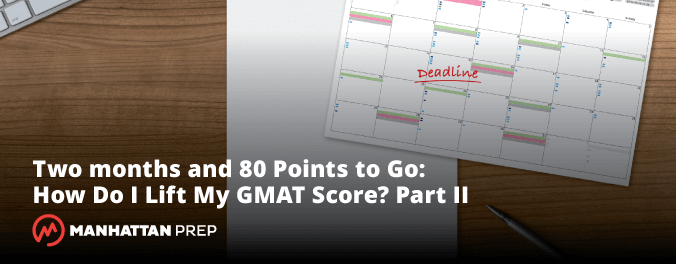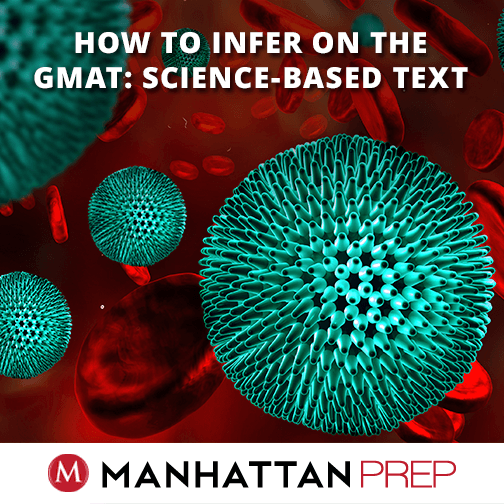Three things to love about GMAT Roman numeral problems
 I. Roman numeral Quant problems aren’t a whole lot of fun.
I. Roman numeral Quant problems aren’t a whole lot of fun.
II. A lot of my students choose to skip them entirely, which is much smarter than wasting five minutes wondering what to do!
III. However, it’s possible to turn this rare and tricky problem type into an opportunity.
Read on, and learn why many GMAT high-scorers love Roman numeral problems. Read more
Here’s why you should take the GMAT twice.

Over the past five or so years, I have seen more and more students take the GMAT twice.
Two months and 80 points to go: How do I raise my GMAT score? (Part 2)
 In the first part of this series, we talked about how to analyze your strengths and weaknesses and in which categories of “low hanging fruit” to concentrate your studies.
In the first part of this series, we talked about how to analyze your strengths and weaknesses and in which categories of “low hanging fruit” to concentrate your studies.
We left off talking about timing; let’s talk about how to make better decisions as you take the test. Read more
Two months and 80 points to go: How do I raise my GMAT score? (Part 1)
 Most second-round deadlines are in early January, so around now, a lot of people are asking me how to eke out the last 30 to 80 points they need to reach their goal.
Most second-round deadlines are in early January, so around now, a lot of people are asking me how to eke out the last 30 to 80 points they need to reach their goal.
Let’s talk about what to do to try to lift your score that last bit in the final 2 months of your study.
Is this article for me?
Tackling Max/Min Statistics on the GMAT (part 3)

Welcome to our third and final installment dedicated to those pesky maximize / minimize quant problems. If you haven’t yet reviewed the earlier installments, start with part 1 and work your way back up to this post.
I’d originally intended to do just a two-part series, but I found another GMATPrep® problem (from the free tests) covering this topic, so here you go:
“A set of 15 different integers has a median of 25 and a range of 25. What is the greatest possible integer that could be in this set?
“(A) 32
“(B) 37
“(C) 40
“(D) 43
“(E) 50”
Here’s the general process for answering quant questions—a process designed to make sure that you understand what’s going on and come up with the best plan before you dive in and solve:

Fifteen integers…that’s a little annoying because I don’t literally want to draw 15 blanks for 15 numbers. How can I shortcut this while still making sure that I’m not missing anything or causing myself to make a careless mistake?
Hmm. I could just work backwards: start from the answers and see what works. In this case, I’d want to start with answer (E), 50, since the problem asks for the greatest possible integer.
Read more
How to Infer on the GMAT
 We’re going to kill two birds with one stone in this week’s article.
We’re going to kill two birds with one stone in this week’s article.
Inference questions pop up on both Critical Reasoning (CR) and Reading Comprehension (RC), so you definitely want to master these. Good news: the kind of thinking the test-writers want is the same for both question types. Learn how to do Inference questions on one type and you’ll know what you need to do for the other!
That’s actually only one bird. Here’s the second: both CR and RC can give you science-based text, and that science-y text can get pretty confusing. How can you avoid getting sucked into the technical detail, yet still be able to answer the question asked? Read on.
Try this GMATPrep® CR problem out (it’s from the free practice tests) and then we’ll talk about it. Give yourself about 2 minutes (though it’s okay to stretch to 2.5 minutes on a CR as long as you are making progress.)
“Increases in the level of high-density lipoprotein (HDL) in the human bloodstream lower bloodstream cholesterol levels by increasing the body’s capacity to rid itself of excess cholesterol. Levels of HDL in the bloodstream of some individuals are significantly increased by a program of regular exercise and weight reduction.
“Which of the following can be correctly inferred from the statements above?
“(A) Individuals who are underweight do not run any risk of developing high levels of cholesterol in the bloodstream.
“(B) Individuals who do not exercise regularly have a high risk of developing high levels of cholesterol in the bloodstream late in life.
“(C) Exercise and weight reduction are the most effective methods of lowering bloodstream cholesterol levels in humans.
“(D) A program of regular exercise and weight reduction lowers cholesterol levels in the bloodstream of some individuals.
“(E) Only regular exercise is necessary to decrease cholesterol levels in the bloodstream of individuals of average weight.”
Got an answer? (If not, pick one anyway. Pretend it’s the real test and just make a guess.) Before we dive into the solution, let’s talk a little bit about what Inference questions are asking us to do.
Inference questions are sometimes also called Draw a Conclusion questions. I don’t like that title, though, because it can be misleading. Think about a typical CR argument: they usually include a conclusion that is…well…not a solid conclusion. There are holes in the argument, and then they ask you to Strengthen it or Weaken it or something like that.
Read more
Top GMAT Prep Courses: Interview with Manhattan Prep Instructor Ron Purewal
 The following excerpt comes from Top GMAT Prep Courses, a helpful resource for comparing your GMAT prep options, gathering in-depth course reviews, and receiving exclusive discounts. Top GMAT Prep Courses had the chance to connect with Ron Purewal, one of Manhattan Prep’s veteran GMAT instructors, to ask questions about the GMAT that we hope all prospective MBA candidates will benefit from. Want more? Head on over to the full article!
The following excerpt comes from Top GMAT Prep Courses, a helpful resource for comparing your GMAT prep options, gathering in-depth course reviews, and receiving exclusive discounts. Top GMAT Prep Courses had the chance to connect with Ron Purewal, one of Manhattan Prep’s veteran GMAT instructors, to ask questions about the GMAT that we hope all prospective MBA candidates will benefit from. Want more? Head on over to the full article!
What are the most common misconceptions of the GMAT that you notice on a regular basis?
“There are two BIG misconceptions in play here.
The first is “knowledge.” Too many people view this test as a monumental task of memorization. A test of knowing stuff. If you’re new to this exam, it’s understandable that you might think this way. After all, that’s how tests have always worked at school, right? Right. And that’s exactly why the GMAT doesn’t work that way. Think about it for a sec: When it comes to those tests, the tests of knowing stuff, you already have 16 or more years of experience (and grades) under your belt. If the GMAT were yet another one of those tests, it would have no utility. It wouldn’t exist. Instead, the GMAT is precisely the opposite: It’s a test designed to be challenging, and to test skills relevant to business school, while requiring as little concrete knowledge as possible.
If you’re skeptical, go work a few GMAT problems. Then, when the smoke clears, take an inventory of all the stuff you had to know to solve the problem, as opposed to the thought process itself. You’ll be surprised by how short the list is, and how elementary the things are. The challenge isn’t the “what;” it’s the “how.” …Continue reading for the second misconception.
How common is it for a student to raise his or her GMAT score 100 points or more, and what is the largest GMAT score increase you’ve personally seen while working at Manhattan Prep?
“We’ve seen such increases from many of our students. I’ve even seen a few increases of more than 300 points, from English learners who made parallel progress on the GMAT and in English itself. I don’t have statistics, but what I can give you is far more important: a list of traits that those successful students have in common.
1) They are flexible and willing to change. They do not cling stubbornly to “preferred” or “textbook” ways of solving problems; instead, they simply collect as many different strategies as possible.
2) They are resilient. When an approach fails, they don’t internalize it as “defeat,” and they don’t keep trying the same things over and over. They just dump the approach that isn’t working, and look for something different. If they come up empty, they simply disengage, guess, and move on.
3) They are balanced. They make time to engage with the GMAT, but they don’t subordinate their entire lives to it. They study three, four, five days a week—not zero, and not seven. They review problems when they’re actually primed to learn; they don’t put in hours just for the sake of putting in hours. If they’re overwhelmed, exhausted, or distressed, they’ll shut the books and hit them another day. In short, they stay sane… Continue reading for more traits of successful students.
Studying for the GMAT? Take our free GMAT practice exam or sign up for a free GMAT trial class running all the time near you, or online. And, be sure to find us on Facebook and Google+,LinkedIn, and follow us on Twitter!
Okay… I’ve Decided To Postpone For a Year
Recently, we talked about what to try if your deadlines are rapidly approaching and you don’t yet have the score that you want. I’d like to talk about next steps for those of you who decide to postpone your exam and possibly your b-school applications.
I didn’t actually decide “ I just didn’t get the score I wanted
 First, a pep talk. You always have a choice. You could, for example, choose to apply this year but lower your standards in terms of where you apply. In fact, if you fall into certain categories, this may be better than waiting a year to try to get into a better (or, at least, higher-ranked) school. Let’s say that you’re being groomed to take over a family business. The current CEO is getting older. The business is well-established and fairly regional, so actually the best thing might be to get a degree from a respected (but not necessarily top) school in the same geographic region as the company headquarters.
First, a pep talk. You always have a choice. You could, for example, choose to apply this year but lower your standards in terms of where you apply. In fact, if you fall into certain categories, this may be better than waiting a year to try to get into a better (or, at least, higher-ranked) school. Let’s say that you’re being groomed to take over a family business. The current CEO is getting older. The business is well-established and fairly regional, so actually the best thing might be to get a degree from a respected (but not necessarily top) school in the same geographic region as the company headquarters.
On the other hand, let’s say that’s NOT you “ in your case, you’re only willing to spend $100,000+ if you can get into a top-fill-in-the-blank school (top 5? top 10? top 20?), and your current GMAT score is probably going to hold you back. In that case, postponing for a year may be the way to go. Any helpful friends or family members who say, Hey, I thought you were applying to business school! can be told, It’s actually a smarter career move to wait until next year. They don’t need to know that the GMAT had anything to do with that decision.
Read more
Developing a GMAT Study Plan – Part 2
Did you know that you can attend the first session of any of our online or in-person GMAT courses absolutely free? We’re not kidding! Check out our upcoming courses here.
How do you study? More importantly, how do you know that the way in which you’re studying is effective—that is, that you’re learning what you need to learn to improve your GMAT score? Read on!
In the first part of this series, we discussed how to get started with your GMAT study plan: setting up your timeframe, picking out your materials, and so on. (If you haven’t read it yet, please do so before you continue here!) In today’s installment, we’ll talk about how to study and make progress over the actual length of your study timeframe. Read more
Determining Your Trajectory up the GMAT Mountain: Working Within Your Timeline, Pt. 2
 This article, written by Abby Pelcyger and Stacey Koprince, was adapted from our upcoming book, The GMAT Roadmap: Expert Advice Through Test Day. The full book will be available mid-November.
This article, written by Abby Pelcyger and Stacey Koprince, was adapted from our upcoming book, The GMAT Roadmap: Expert Advice Through Test Day. The full book will be available mid-November.
Okay, you have your study timeline mapped out. Now, how do you use your time most effectively?
Climbing the Mountain
Look over your study timeline (for many of you, that may be the syllabus for your Manhattan GMAT class). Look at the assignment you have earmarked for the following week. Get a calendar and block off the time periods during which you will study during the upcoming week. Next to each scheduled appointment, list tasks you intend to accomplish during that time slot. Prioritize the areas that address your weaknesses (as indicated by your CAT analysis results) by placing them earliest in the week. Assign only make-up work to your last study session of the week”trust us: there’ll be plenty of it to do.